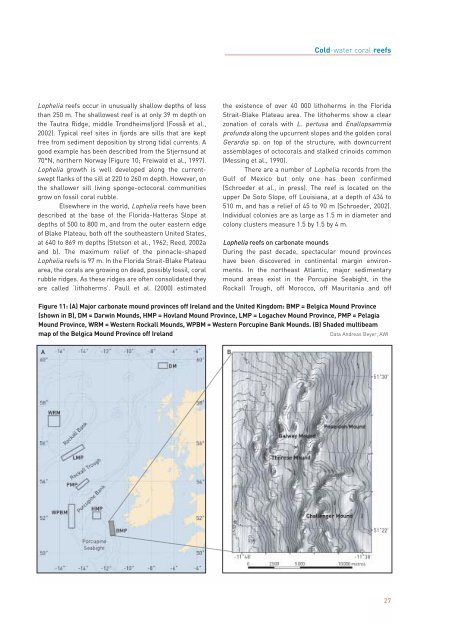Cold-water coral reefs - WWF UK
Cold-water coral reefs - WWF UK
Cold-water coral reefs - WWF UK
You also want an ePaper? Increase the reach of your titles
YUMPU automatically turns print PDFs into web optimized ePapers that Google loves.
<strong>Cold</strong>-<strong>water</strong> <strong>coral</strong> <strong>reefs</strong><br />
Lophelia <strong>reefs</strong> occur in unusually shallow depths of less<br />
than 250 m. The shallowest reef is at only 39 m depth on<br />
the Tautra Ridge, middle Trondheimsfjord (Fosså et al.,<br />
2002). Typical reef sites in fjords are sills that are kept<br />
free from sediment deposition by strong tidal currents. A<br />
good example has been described from the Stjernsund at<br />
70°N, northern Norway (Figure 10; Freiwald et al., 1997).<br />
Lophelia growth is well developed along the currentswept<br />
flanks of the sill at 220 to 260 m depth. However, on<br />
the shallower sill living sponge-octo<strong>coral</strong> communities<br />
grow on fossil <strong>coral</strong> rubble.<br />
Elsewhere in the world, Lophelia <strong>reefs</strong> have been<br />
described at the base of the Florida-Hatteras Slope at<br />
depths of 500 to 800 m, and from the outer eastern edge<br />
of Blake Plateau, both off the southeastern United States,<br />
at 640 to 869 m depths (Stetson et al., 1962; Reed, 2002a<br />
and b). The maximum relief of the pinnacle-shaped<br />
Lophelia <strong>reefs</strong> is 97 m. In the Florida Strait-Blake Plateau<br />
area, the <strong>coral</strong>s are growing on dead, possibly fossil, <strong>coral</strong><br />
rubble ridges. As these ridges are often consolidated they<br />
are called ‘lithoherms’. Paull et al. (2000) estimated<br />
the existence of over 40 000 lithoherms in the Florida<br />
Strait-Blake Plateau area. The lithoherms show a clear<br />
zonation of <strong>coral</strong>s with L. pertusa and Enallopsammia<br />
profunda along the upcurrent slopes and the golden <strong>coral</strong><br />
Gerardia sp. on top of the structure, with downcurrent<br />
assemblages of octo<strong>coral</strong>s and stalked crinoids common<br />
(Messing et al., 1990).<br />
There are a number of Lophelia records from the<br />
Gulf of Mexico but only one has been confirmed<br />
(Schroeder et al., in press). The reef is located on the<br />
upper De Soto Slope, off Louisiana, at a depth of 434 to<br />
510 m, and has a relief of 45 to 90 m (Schroeder, 2002).<br />
Individual colonies are as large as 1.5 m in diameter and<br />
colony clusters measure 1.5 by 1.5 by 4 m.<br />
Lophelia <strong>reefs</strong> on carbonate mounds<br />
During the past decade, spectacular mound provinces<br />
have been discovered in continental margin environments.<br />
In the northeast Atlantic, major sedimentary<br />
mound areas exist in the Porcupine Seabight, in the<br />
Rockall Trough, off Morocco, off Mauritania and off<br />
Figure 11: (A) Major carbonate mound provinces off Ireland and the United Kingdom: BMP = Belgica Mound Province<br />
(shown in B), DM = Darwin Mounds, HMP = Hovland Mound Province, LMP = Logachev Mound Province, PMP = Pelagia<br />
Mound Province, WRM = Western Rockall Mounds, WPBM = Western Porcupine Bank Mounds. (B) Shaded multibeam<br />
map of the Belgica Mound Province off Ireland<br />
Data Andreas Beyer, AWI<br />
A<br />
B<br />
27
















